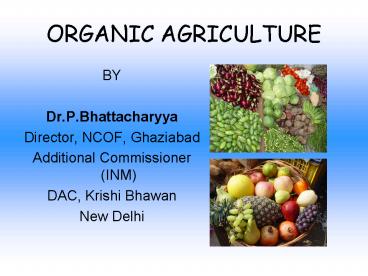ORGANIC AGRICULTURE
1 / 18
Title: ORGANIC AGRICULTURE
1
ORGANIC AGRICULTURE
- BY
- Dr.P.Bhattacharyya
- Director, NCOF, Ghaziabad
- Additional Commissioner (INM)
- DAC, Krishi Bhawan
- New Delhi
2
ORGANIC AGRICULTURE
- Holistic production system, harmony with nature,
Avoids chemical fertiliser, pesticides etc. - PURPOSE
- Good soil, good food, good health, good
environment, good business - Movement from Farmers, NGOs etc.
3
ORGANIC STATUS
- Global 24 mha (1.6 Ag. Area)
- Nearly 130 countries produce organic
product, Australia (10 mha) lead country - Indian 37000-41000 ha (SOEL survey),
(0.3 of Ag. Area) - 2.50 million ha (APEDA)
- (Including 2.43 mha of forest area with
wild herb medicinal plants
4
Main ISSUES
- Standard
- Inspection, Certification, Accreditation
- Input
- Market (Export/Domestic)
5
STANDARD
- Globally 61 standards available
- Important Standard includes IFOAM, CODEX, EU,
Demeter, JAS, Naturland etc. - National Standard in India under NPOP (2002)
(General Principle, Recommendation, Standard,
list (permitted/non-permitted) - Mainly process Standard, cover cultivation,
Fertilisation, Pest/Disease management - recently under review Efforts for harmony with
EU regulation.
6
CERTIFICATION Agencies in India
- 11 Nos.
- Ecocert (G) (Aurangabad), Skal (N) (Bangalore),
IMO (S) (Bangalore), SGS (S) (Gurgaon), Naturland
(G) (Gurgaon), Lacon (G) (Cochin), Indocert (S)
(Cochin), APOF (Bangalore), ISCOP (Coimbatore),
IRFT (Mumbai), Bioinspectra (S) (Cochin) - Mandatory for export market
- ACREDITATION
- Earlier 6 agencies APEDA, Spice Board,
Coffee Board, Coconut Board, Tea Board, Cashew
nut Board - Now one body National Accreditation Board
(APEDA, other Commodity Board and Ministry of
Agriculture) - Limitation i) Inspection performance not always
good - ii) Certification cost is high
7
Organic Input
- Availability
- Live stock 2.47 million ton
- Crop residues 2.00 million ton
- Biogas slurry 0.12 million ton
- Biofertiliser 0.20 million ton
- Green manure 0.10 million ton
- City refuse 0.68 million ton
- Others 1.00 million ton
- (Rural compost, Vermicompost, 6.57 million ton
- Ag. Waste)
- Total 7.0 million ton
- Biopesticide 1000 ton
- Constraint (a) No regulatory mechanism
- (b) Response always not satisfactory.
8
(No Transcript)
9
Market Organic (Export) 2004
Export Product Basmati rice, cotton, Mangopulp,
Cashew nut, Sesame, Piniapple pulp, Honey,
Walnut, spices, coffee, Tea, Peanut canned.
APEDA,
10
Future Export Demand
Exported to Europe Netherland, UK, Germany,
Belgium, Sweeden, Switzerland, France, Italy,
Spain America USA, Canada Middle East Saudi
Arabia, UAE Asia Japan, Singapore
(Source Org. Marg 2002) In 2002, from a total
food production over 200 million ton, India
produced only 14000 ton of organic food produces
11
Major products produced in India by Organic
Farming
12
Name of few Organic Exporters
- Sunstar overseas Ltd. Haryana
- Navdanya Trust, New Delhi
- FAB India Ltd., New Delhi
- Kashmir Apiaries Export
- Jubilant Organosys Ltd., Noida
- IITC Organic India Ltd., Lucknow
13
Domestic Market
- Yet to be developed
- No market structure is there
- Emphasis on
- (i) Creation of awareness
- (ii) Procuder consumer meeting, organisation
of organic bazar/hat/mela - (iii) Change of mindset
- (iv) utilisation of spiritual group, health care
group etc.
14
Value Addition for food processing organic view
point
- Value addition for food process most important
for agribusiness - Type of value Addition include
- Use of additive, flavors
- Fortification with vitamin, amino acid
- Nutrient supplementation
- Protective packaging
- Raising food safety by detoxification (removal of
Alfa toxin, Glucocinolate) - Reduction of ant nutritional factors (trypsin
inhibitiors, tannins etc.) - Use of antioxidant
- Use of chemical preservative, salt
- Imparting desirable taste (salting of cashew nut)
- Improvement in hygienic quality
15
Guideline of Organic Standard for food process
- Handling/processing of organic products should be
optimized to maintain quality - Pollution sources should be identified
- Flavoring extracts preferably be organic
- Product shall be protected with non-organic
product - Organic non-organic product shall not be stored
transported together. - Special condition of storage permitted
(controlled atmosphere, cooling, freezing,
Drying) - Humidity regulation ethylene gas for ripening
permitted - Biodegradable packaging materials shall be used
- (Packaging through product like benzooxazolyl,
methoxymethyl flourine etc. prohibited)
16
India Organic An overview
- Advantage in climate 100-10000 mm rain, hilly,
desert - diversive - Blessed with vast natural resources.
- Area Under certified 2.5 million ha.
- Total certified product 115,238 metric ton
- Project certified 332
- No. of processing units 158
- Accredited I C agencies 11
- Total Quantity exported 6,472 MT (2004)
- No. of products exported 35
17
Government Initiative(As facilitator)
- NPOP programme (2000), National Standard,
Accreditation, Certification, Organic export
through Ministry of Commerce, APEDA. - Development of Organic Farming Technology package
by ICAR - Launching of National Project on Promotion of
Organic Farming (w.e.f. October, 2004) (Rs.57.0
crore) (10th five year plan) - Capacity Building through Service providers
- Setting up of vermiculture hatchery,
Biofertiliser plant, Fruit/Vegetable compost
plant (25 Back ended bankable project) - Human Resource Development through training,
field demonstration. - Setting up of model organic farm
- Quality testing and input production technology
- Market development, publicity etc.
- Budget for 2005-06 on Organic Farming under NPOF
Rs.27 crore
18
THANK YOU
LIVE ORGANIC
EAT ORGANIC
DREAM ORGANIC































